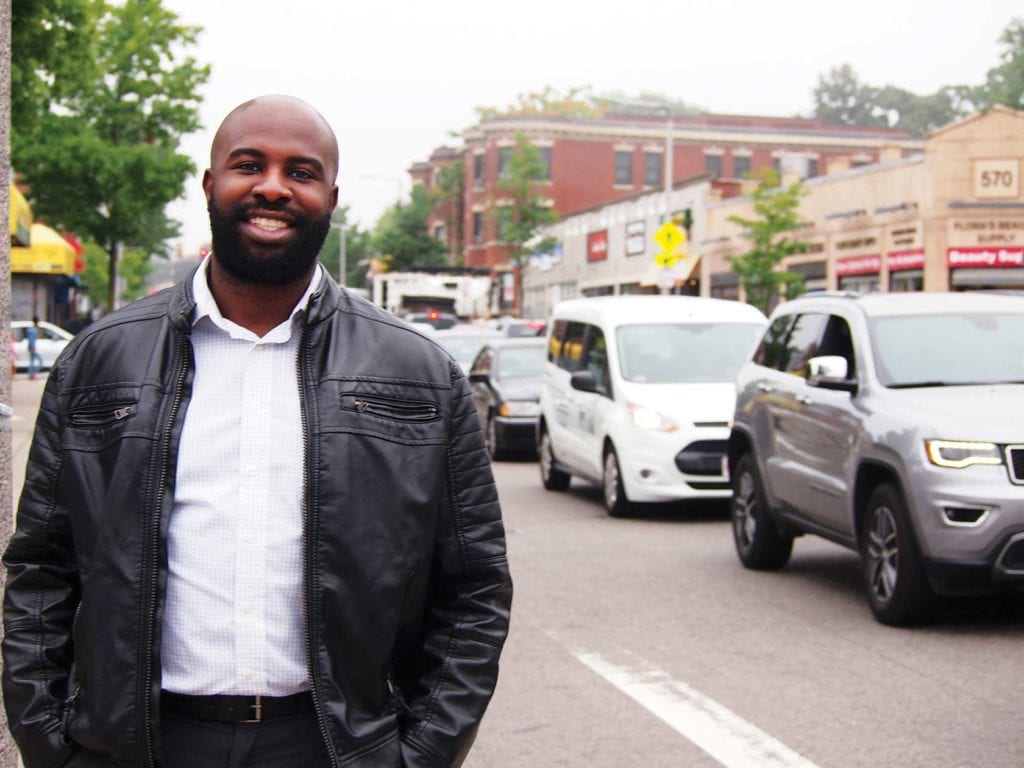Boston activists strategize on housing affordability
Some advocate a ‘yes-in-my-backyard’ approach

The boom times for Boston’s building trades show no signs of abating, with high-end towers such as One Dalton Street advertising units for as much as $40 million.
At an event to mark the “topping off” — the completion of the steel work on the top level of the 742-foot hotel and condo tower — Mayor Martin Walsh said the city’s latest luxury high-rise will benefit the city’s supply of lower income units, noting that the developers would be paying into funds that would support 28 affordable units.

Mayor Martin Walsh attends the topping off ceremony for the One Dalton tower. photo: Mayor’s Office photo by John Wilcox
“Often times people talk about luxury buildings, saying that we’re not building for the poor,” Walsh told reporters. “But what this building actually does is create opportunities and revenue for middle-class and low-income housing.”
The Walsh administration has presided over the permitting and construction of 5,761 affordable units as part of its longterm strategy to create 53,000 new housing units by 2030. With a total of 17,205 new units permitted or under construction in Boston, and another 20,700 units in the planning stages, the city is well on its way to meeting the 2030 goal.
The Walsh administration is not alone in its push for production as a means to ease pressure on the housing market. There are small but growing movements in Boston to promote greater density as a means of increasing affordability and to accommodate the growth in population in the city. By 2050 Boston’s population is expected to grow from the current 667,000 to 801,000. While the latter number matches the city’s all-time high population in 1950, many housing units were demolished during the following decades as the population plummeted to 562,000 by 1980.
Yet in the city’s neighborhoods, many complain that so far, increased housing production is doing little to ease pressure on rents. The cost of renting is rising again after a brief period of stability, in spite of increased housing production.
“Builders aren’t building for the average Bostonian,” says District 1 City Councilor Lydia Edwards. “They don’t have to, and that’s not how the market works. They’re building and making as much money as they can off of it.”
Edwards is far from alone in her assessment. Some cite a study released earlier this year that estimated that increases in housing production would lead to no significant reductions in rents and concluded that rents are more closely tied to the level of amenities in a neighborhood than to the supply of housing. One analyst, reviewing the study, noted that “no one knows how much housing you’d have to add to have any significant impact on costs.”
Boston remains the fourth most expensive rental market in the country, with the average rent for an apartment at Boston now at $2,152.
Density and affordability in Dorchester
The city’s largest and most populous neighborhood provides a snapshot of the at-times competing ideas about affordability, density and growth in Boston.
A group calling itself Dorchester Growing Together is advocating a YIMBY, or “yes-in-my-backyard” approach to development, calling on Dorchester residents to support the dense development projects commonly shunned by abutters in Boston neighborhoods.
“Boston’s population growth will continue, putting our neighborhood at risk of even higher housing costs, since unwillingness to build only forces residents and newcomers into a competition for existing housing stock,” members of the group wrote in an op-ed in the Dorchester Reporter.
“We’re seeing tons and tons of people moving into communities all over the Greater Boston area,” says DGT member Jarred Johnson, an Oklahoma City native who lives in Dorchester and works for the Codman Square Neighborhood Development Corporation. “I don’t want to say ‘no’ to new economic opportunity. I think there are ways we can grow equitably.”
On the other side of the equation, members of the group Dorchester Not For Sale caution that many of the development projects in the pipeline for the neighborhood are not affordable to people currently living there.
“The economics of supply and demand don’t work in the housing market,” says lifelong Dorchester resident Lori Hurlebaus, who works in food service. “Economics isn’t that simple, especially when you have a market that is based on speculation and profit.”
Hurlebaus says market-rate housing in Boston is essentially luxury housing. She has a point. Of the 5,761 subsidized units produced by the city, the majority — 3,738 — are affordable to those making 60 to 120 percent of the area median income, which works out to $42,000 to $82,000 for an individual.
But the area median income factors in high-income municipalities surrounding Boston including Cambridge, Brookline and Newton. The median income for the city of Boston alone is $35,000, meaning that more than half the city’s wage earners could not afford to rent or buy the majority of the moderately affordable units produced.
The Dot Block development project promises 362 units, with 47 designated affordable, at the corner of Hancock Street and Dorchester Avenue. It’s not likely that many who reside in adjacent areas such as Bowdoin Street and Meetinghouse Hill could afford to live in the development, even with subsidy.
“Market rate rents are luxury,” Hurlebaus says. “They’re out of reach for most of the people who now live in this city.”
Solutions?
Johnson, the Dorchester Growing Together member, agrees that density alone is not the solution for the city.
“Most of what we’re building is luxury units,” he says. “The city and neighbors must do better to encourage the development of middle-income housing.”
He says that buildings with increased density and prefabricated units can lower per-unit construction costs, a savings that could be passed on to homebuyers and renters.
Hurlebaus says developers should match the housing they build to the needs of the residents currently residing here.
Edwards says some of the city’s new programs show promise. Allowing accessory dwelling units — small units built as additions to existing buildings or in back yards, could help provide more affordable housing solutions.
She also says the requirement that large developments make 13 percent of their units is too low, arguing for 20 percent, as is the case in neighboring Cambridge.
“I think there’s a certain fear that if we put in higher requirements, people won’t build at all,” she says. “But I don’t know where that’s ever happened.”







